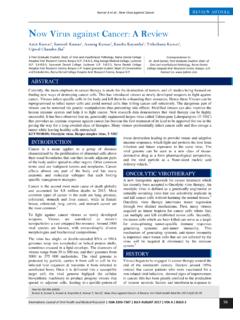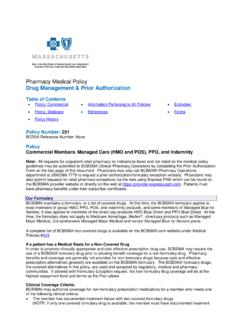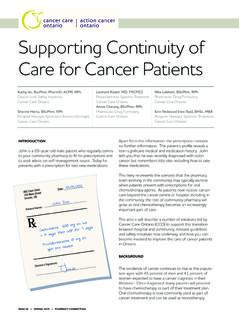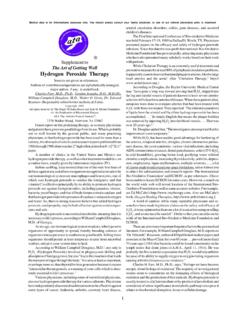Transcription of DRUG NAME: Thiotepa
1 Thiotepa drug NAME: Thiotepa SYNONYM(S): TESPA,1 TSPA1 COMMON TRADE NAME(S): CLASSIFICATION: alkylating agent Special pediatric considerations are noted when applicable, otherwise adult provisions apply. MECHANISM OF ACTION: Thiotepa , a derivative of nitrogen mustard, acts as a polyfunctional alkylating Alkylation takes place through the formation of a highly reactive ethylenimine This radical likely forms a cross-linkage between two strands of DNA,2 interfering with DNA, RNA, and protein ,3 These actions do not appear to be cell cycle phase-specific. Thiotepa has immunosuppressive Intracavitary (intra-pleural, -pericardial, and -peritoneal) administration of Thiotepa also produces an inflammatory reaction on serous membranes with a resulting sclerosing PHARMACOKINETICS: Oral Absorption variable as unstable in acidic pH; therefore, not administered orally peak plasma concentrations occur immediately; lipid-soluble,4 variable absorption occurs through serous membranes and from IM injection, peritoneum (80-100%), bladder (10-100%) IT: diffuses rapidly out of the CSF5,6 cross blood brain barrier?
2 5,7,8 yes; triethylenephosphoramide metabolite (TEPA): yes4 volume of distribution1,9 L/kg Distribution plasma protein binding 8-29%; TEPA more extensively bound extensive hepatic metabolism; involves the hepatic microsomal enzyme oxidation system and glutathione conjugation9,10; Thiotepa is metabolized to TEPA by CYP 3A4 (major) and CYP 2B6 (minor)10 active metabolite(s)2 yes; including TEPA; when given IT, TEPA is not formed in the CNS Metabolism inactive metabolite(s) yes biphasic elimination; renal <1%; excreted in sweat to an appreciable extent with high-dose IV urine ; TEPA: 4%; unidentified metabolites with alkylating activity: 13-24% feces no information found terminal half life2,3 h; TEPA: 10-21 h Excretion clearance 180-780 mL/min/m2 Adapted from standard reference1 unless specified otherwise.
3 BC Cancer Agency Cancer drug Manual Page 1 of 7 Thiotepa Developed: 1994 Revised: 1 October 2008, 1 June 2013 Thiotepa USES: Primary uses: Other uses: *Bladder cancer (intravesical) *Breast cancer Malignant meningeal neoplasms1,11 (intrathecal) High-dose for myeloablation prior to bone marrow transplant9 *Intracavitary effusions secondary to malignancy *Ovarian cancer *Health Canada approved indication SPECIAL PRECAUTIONS.
4 Existing hepatic or renal damage2; see DOSAGE GUIDELINES skin reactions including depigmentation and dermatitis have occurred after accidental exposure; safe handling precautions should be followed when handling Thiotepa ; if skin contact occurs, wash the area thoroughly with soap and water; if mucous membrane contact occurs, flush thoroughly with water2 Carcinogenicity: Thiotepa is Mutagenicity: Mutagenic in Ames test and mammalian in vitro mutation Thiotepa is clastogenic in mammalian in vitro and in vivo chromosome Fertility: Amenorrhea and impaired spermatogenesis have been Pregnancy.
5 FDA Pregnancy Category There is positive evidence of human fetal risk,2 but the benefits from use in pregnant women may be acceptable despite the risk ( , if the drug is needed in a life-threatening situation or for a serious disease for which safer drugs cannot be used or are ineffective). Breastfeeding is not recommended due to the potential secretion into breast SIDE EFFECTS: The table includes adverse events that presented during drug treatment but may not necessarily have a causal relationship with the drug . Because clinical trials are conducted under very specific conditions, the adverse event rates observed may not reflect the rates observed in clinical practice.
6 Adverse events are generally included if they were reported in more than 1% of patients in the product monograph or pivotal trials, and/or determined to be clinically ORGAN SITE SIDE EFFECT Clinically important side effects are in bold, italics allergy/immunology allergic reactions (1-10%)3 myelosuppression (>10%)3; cumulative1 and dose-related; may occur up to 30 days after treatment1; deaths reported anemia leukopenia; nadir1 typically days 10-14 blood/bone marrow/ febrile neutropenia thrombocytopenia; onset3 typically days 7-10, nadir day 14, recovery day 28 fatigue (1-10%)3 constitutional symptoms fever (1-10%)3; secondary to tumour breakdown dermatology/skin extravasation hazard: none13 BC Cancer Agency Cancer drug Manual Page 2 of 7 Thiotepa Developed: 1994 Revised: 1 October 2008, 1 June 2013 Thiotepa BC Cancer Agency Cancer drug Manual Page 3 of 7 Thiotepa Developed: 1994 Revised: 1 October 2008, 1 June 2013 ORGAN SITE SIDE EFFECT Clinically important side effects are in bold, italics alopecia (1-10%)3 discharge from subcutaneous lesions.
7 Secondary to tumour breakdown hyperpigmentation3 (1-10%)3; with high-dose BMT therapy3 rash (1-10%)3; pruritis3 (1-10%)3; urticaria (1-10%)3; dermatitis skin reactions including contact dermatitis and depigmentation3; with topical exposure3 emetogenic potential: low14 anorexia (1-10%)3 nausea and vomiting (1-10%)3 gastrointestinal stomatitis, mucositis; dose-limiting with high-dose BMT therapy3,15 hemorrhage hemorrhage; secondary to myelosuppression; deaths have occurred infection septicemia; deaths have occurred serum transaminitis and hyperbilirubinemia; with high-dose BMT therapy3 metabolic/laboratory hyperuricemia1,3 (1-10%)3 musculoskeletal weakness (1-10%)3 confusion, inappropriate behavior; with high-dose BMT therapy3 dizziness (1-10%)3 neurology somnolence.
8 With high-dose BMT therapy3 blurred vision ocular/visual conjunctivitis (1-10%)3 abdominal pain dysuria headache (1-10%)3 pain injection site pain (>10%)3 renal/genitourinary urinary retention (1-10%)3 secondary malignancy myelodysplastic syndrome and acute non-lymphocytic leukemia (<1%)3 sexual/reproductive function amenorrhea (1-10%)3; impaired spermatogenesis Adapted from standard reference2 unless specified otherwise. Intrathecal administration is typically well Systemic toxicities are infrequent with the exception of Neurologic toxicities including weakness and paresthesia16 and aseptic chemical meningitis, characterized by fever, headache, nausea and vomiting, meningismus, photophobia, and dehydration may Better drug exposure may be achieved if given IV because Thiotepa diffuses rapidly out of the CNS and the active metabolite TEPA is not formed in the Intravesical administration may cause systemic toxicities due to absorption, including myelosuppression17,18 (3-54%.)
9 Deaths reported2) and allergic reactions19 (3%). Absorption is variable15,17 (10-100%) and is increased by multiple tumours, tumour infiltration, mucosal inflammation, and reflux of urine from the bladder into the ,17 Dose-dependant chemical cystitis (1-69%)3,17,18 may occur; however, hemorrhagic cystitis is ,18 Delay therapy Thiotepa or dose reduce to manage irritative Rarely, eosinophilic cystitis,20 azoospermia,18 and non-lymphocytic leukemia and myelodysplastic syndrome have been INTERACTIONS: AGENT EFFECT MECHANISM MANAGEMENT aprepitant21 delayed and decreased exposure to TEPA (20%) inhibition of CYP enzymes (likely 3A4 and 2B6) minor clinical importance due to large inter- and intra-individual variability in Thiotepa clearance phenytoin22,23 increased rate of Thiotepa conversion to TEPA strong induction of CYP 2B6 enzyme by phenytoin avoid concurrent use.
10 If used consider dose reduction of Thiotepa succinylcholine,2 pancuronium22 prolonged apnea may occur Thiotepa may inhibit pseudocholinesterase activity caution; consider avoiding concurrent use Thiotepa is a major CYP 2B6 inhibitor; therefore, serum levels/effects of drugs or herbs that are CYP 2B6 substrates may be SUPPLY AND STORAGE: Injection: Bedford Laboratories supplies Thiotepa as 15 mg single-use vials of nonpyrogenic, sterile, lyophilized For basic information on the current brand used at the BC Cancer Agency, see Chemotherapy Preparation and Stabilit













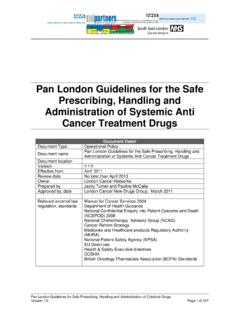
![[Product Monograph Template - Standard]](/cache/preview/1/3/7/9/6/d/a/a/thumb-13796daa617bc65beb773a3c01593750.jpg)
